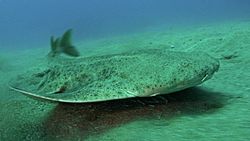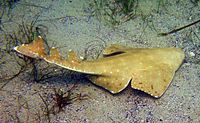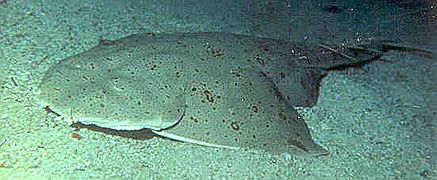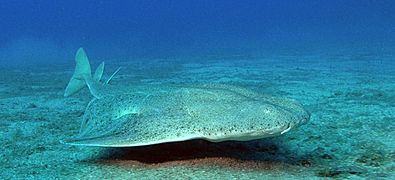Angel shark facts for kids
Quick facts for kids Angel sharksTemporal range: Upper Jurassic – present
161 mya – present |
|
|---|---|
 |
|
| The Angel shark Squatina squatina | |
| Scientific classification | |
| Kingdom: | |
| Class: | |
| Subclass: | |
| Order: |
Squatiniformes
|
| Family: |
Squatinidae
|
| Genus: |
Squatina
|
| Type species | |
| Squalus squatina Linnaeus, 1758
|
|
An angel shark is a species of cartilaginous fish in the genus Squatina. They have flattened bodies and wide pectoral fins, which make them look similar to rays. Twenty-three species are known.
The genus is the only one in its family, Squatinidae, and order Squatiniformes. They are worldwide in temperate and tropical seas. Most species are in shallow temperate or tropical seas, but one species is found in deeper water, down to 1,300 metres. Angel sharks are specialised for a kind of predation which is unusual for sharks. They are ambush predators. They have extensible jaws with long, needle-like teeth. They quickly snap upwards to capture prey. They bury themselves in sand or mud lying in wait for their prey, which includes fish, crustaceans, and many different types of mollusks.
Discription and biology
The front part of the angel sharks' bodies are wide and flattened, but the back part is more muscular. The eyes and spiracles are on the top, and the five gill slits are on its back. Both the pectoral fins and the pelvic fins are large and are held horizontally. There are two dorsal fins, no anal fin. Unusually for sharks, the lower lobe of the caudal fin is longer than the upper lobe. Most types of angel sharks grow to a length of about 1.5 metres: the Japanese angelshark reaches two metres. They are ovoviviparous, and can have up to 13 pups at a time.
Habitat
Angel sharks inhabit temperate and tropical marine environments. They are generally found in shallow waters at depths from 10 to 328 feet off coasts. They are known to bury themselves in sandy or muddy environments during the day, where they remain camouflaged for weeks until a desirable prey crosses paths with them. At night, they take a more active approach and cruise on the bottom of the floor. Squatina preys on fish, crustaceans, and cephalopods.
Behavior
Although angel sharks are bottom dwellers and appear harmless, they can give painful bites if provoked, due to their powerful jaws and sharp teeth. Angel sharks may bite if a diver approaches the head or grabs the tail.
Angelsharks have a unique way of breathing compared to most other benthic fish. They do not pump out water from the oropharyngeal cavity like other fish. Instead they use gill flaps located under their body to pump out water during respiration. Doing so also allows them to be more discreet and prevent detection.
Commercial value
Prior to the late 1980s, the Pacific angel shark was considered a "munk fish". It was a byproduct of commercial gillnetting, with no commercial appeal and was used only for crab bait. In 1977, Michael Wagner, a fish processor in Santa Barbara, California, US, in cooperation with local commercial fishermen, developed the market for angel sharks. The annual take of angel shark in 1977 was an estimated 147 kg. By 1985, the annual take of angel shark on the central California coast had increased to more than 454 tonnes or an estimated 90,000 sharks. The population declined dramatically and is now regulated. Angel sharks live very close to shore, resulting in high bycatch rates. In 1991, the use of gillnets in nearshore state waters of California was forbidden, and fishing was restricted in a larger portion of the Pacific angel shark's range.
In April 2008, the UK government afforded the angel shark full protection under the Wildlife and Countryside Act. Once considered abundant in the Atlantic Ocean, the angel shark (Squatina squatina) was classified as "critically endangered" in 2010.
Species
Currently, the 26 recognized species in this genus are:
- Squatina aculeata G. Cuvier, 1829 (sawback angelshark)
- Squatina africana Regan, 1908 (African angelshark)
- Squatina albipunctata Last & W. T. White, 2008 (eastern angelshark)
- Squatina argentina (Marini, 1930) (Argentine angelshark)
- Squatina armata (Philippi {Krumweide}, 1887) (Chilean angelshark)
- Squatina australis Regan, 1906 (Australian angelshark)
- Squatina caillieti J. H. Walsh, Ebert & Compagno, 2011 (Philippines angelshark)
- Squatina californica Ayres, 1859 (Pacific angelshark)
- Squatina david Acero P, Tavera Vargas, Anguila-Gómez & Hernández-Beracasa, 2016 (David's angelshark)
- Squatina dumeril Lesueur, 1818 (sand devil)
- Squatina formosa S. C. Shen & W. H. Ting, 1972 (Taiwan angelshark)
- Squatina guggenheim Marini, 1936 (angular angelshark)
- Squatina heteroptera Castro-Aguirre, Espinoza-Pérez & Huidobro-Campos, 2007 (disparate angelshark)
- Squatina japonica Bleeker, 1858 (Japanese angelshark)
- Squatina legnota Last & W. T. White, 2008 (Indonesian angelshark)
- Squatina mapama Long, Ebert, Tavera, Pizarro, and Robertson, 2021 (Small-crested angelshark)
- Squatina mexicana Castro-Aguirre, Espinoza-Pérez & Huidobro-Campos, 2007 (Mexican angelshark)
- Squatina nebulosa Regan, 1906 (clouded angelshark)
- Squatina occulta Vooren & K. G. da Silva, 1991 (hidden angelshark)
- Squatina oculata Bonaparte, 1840 (smoothback angelshark)
- Squatina pseudocellata Last & W. T. White, 2008 (western angelshark)
- Squatina punctata Marini 1936
- Squatina squatina (Linnaeus, 1758) (angelshark)
- Squatina tergocellata McCulloch, 1914 (ornate angelshark)
- Squatina tergocellatoides J. S. T. F. Chen, 1963 (ocellated angelshark)
- Squatina varii Vaz & Carvalho, 2018 (Brazilian angelshark)
See also
 In Spanish: Tiburones ángel para niños
In Spanish: Tiburones ángel para niños







